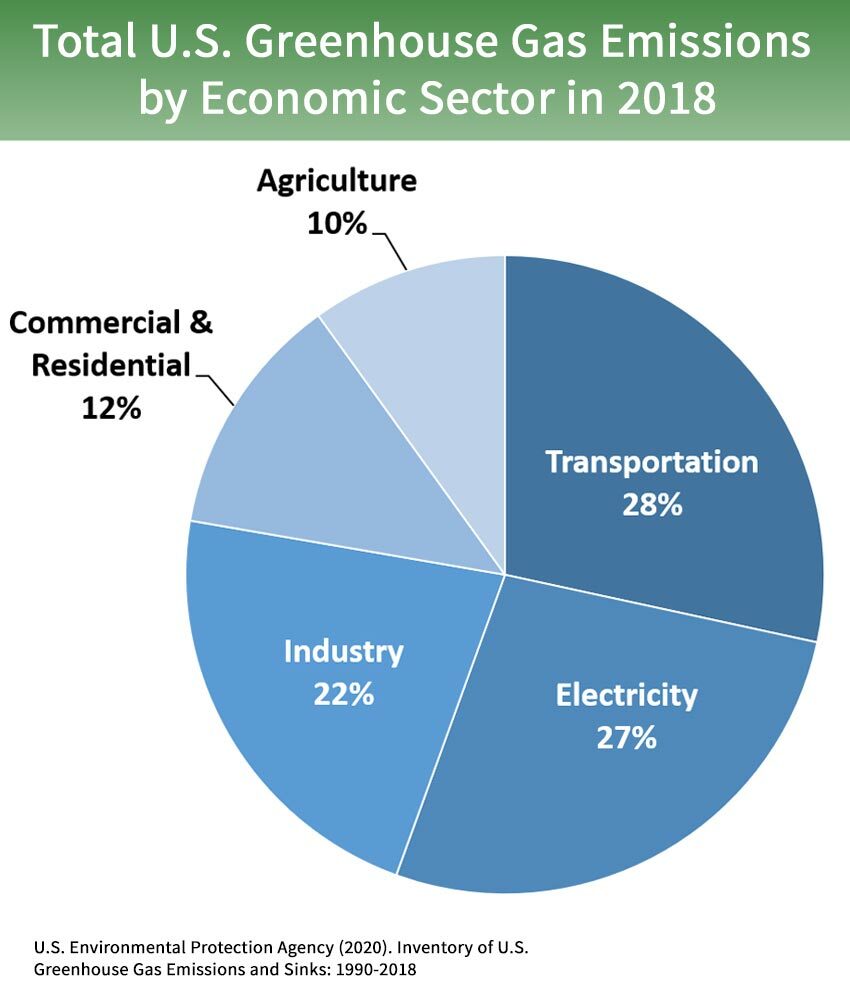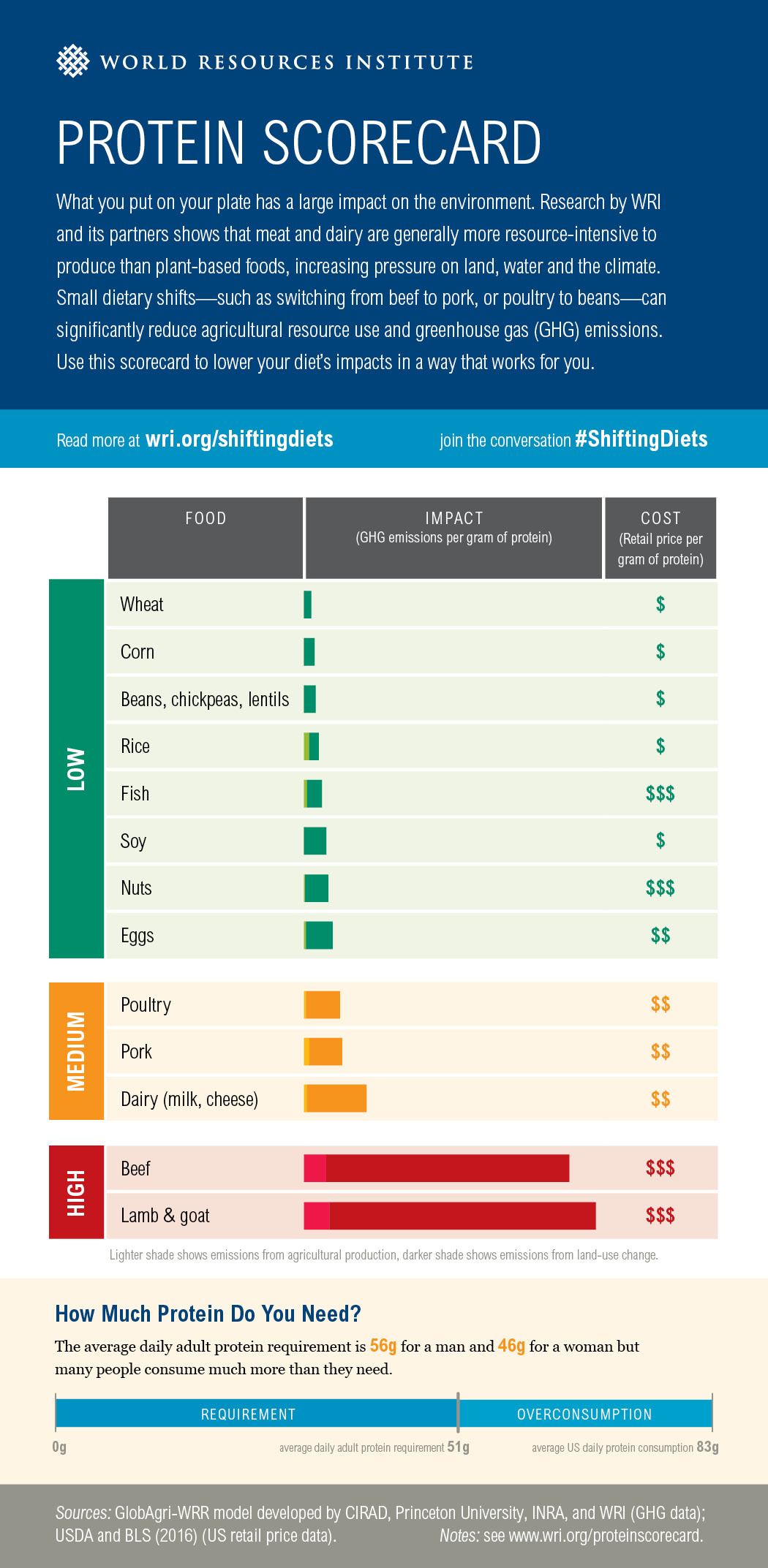The Environmental Impact of Food

The forces driving climate change are widespread and varied. According to the Environmental Protection Agency, the biggest culprits in the U.S. are transportation (28%), electricity (27%), industry (22%), and commercial and residential energy use (12%), totaling 89% of total greenhouse gas (GHG) emissions. [1] This aligns with other reports on regional emissions, including that of the European Environment Agency. [2]

This leaves approximately 10% from agricultural practices, which includes everything from raising livestock to the maintenance of agricultural soils and things like rice production. Because of this diversity, it’s sometimes difficult to parse the data and pinpoint the impact of the different constituents within this sector of the emissions equation.
Nevertheless, given the abundance of misinformation surrounding the forces driving climate change and environmental degradation, let’s turn our attention to the most frequently asked, and most often misunderstood, questions regarding the environmental impact of the foods we eat.
The Big Impact of Beef
There’s no debate that feed lots contribute to GHGs. Beef production is the biggest culprit, both through the production process and through land-use change. An increase in beef production requires more land, which are often created by clear-cutting trees. This releases carbon dioxide stored in forests.
A 2013 study by the U.N. Food and Agriculture Organization estimated that “total annual emissions from animal agriculture (production emissions plus land-use change) were about 14.5% of all human emissions. Of that figure, beef contributed 41%.” [3]
Data strongly suggests that beef production is much more resource-intensive than other foods. In fact, a report produced by the World Resources Institute found that beef requires 20 times more land (and emits 20 times more GHG emissions) per gram of edible protein than plant proteins. [4]

Ways to Reduce Emissions from Beef Production
Though it will always be more resource-intensive than other food sources, beef production can be improved. Everything from feed quality to breeding practices and veterinary care will need to be considered to improve efficiency.
Better management practices can also make a big impact. Rotational grazing, for instance, can boost productivity and soil health while reducing emissions. The practice of alternating between crop production and grazing can lead to superior yields for both practices.
Through regenerative grazing, farmers and ranchers can take advantage of the natural behavior of cattle—to stomp all over pastureland—to add organic matter and oxygenate the soil. This helps grasses and other more desirable plants to flourish. When done properly, this practice can restore the health of the pasture. Regenerative agriculture can also include the strategic rotation of crops, and greater use of compost rather than chemical fertilizers.
The practices are rapidly gaining popularity among small farmers and big agribusiness alike. Furthermore, the Biden administration’s plans to combat climate change list agriculture as a “linchpin” of its strategy, and even suggests allocating $1 billion to pay farmers to trap carbon in the soil. [5]
While there is broad consensus that regenerative practices help with soil health, their ability to sequester carbon and combat climate change is far more controversial. Much more research will be needed before a conclusive answer is reached.
Don’t Crops Also Contribute to Greenhouse Gases?
Any comparison between the sources of GHGs within the “agriculture” sector should be made by looking at different food sources in terms of acreage. In other words, how many calories does an acre produce versus how many greenhouse gases does an acre produce? This is the only reasonable way to compare sources.
Yes, crops certainly contribute to GHGs. But the contribution is not as large as you think. The density of calories produced from animals on a given piece of land is far less than it is with plants. That’s because you can cram a lot of calories from grains into one acre.
Keep in mind, however, that roughly half of U.S. agricultural production emissions (and 20% globally) are related to the use of synthetic fertilizers and manure. Most of these emissions are from nitrous oxide, a potent greenhouse gas. [6]
While agriculture in the United States and around the globe is a net contributor of GHG emissions, farms and pastures also store carbon in their vegetation and soils. According to the global research organization World Resources Institute, “in addition to stabilizing the existing U.S. carbon sink by protecting forests and other natural landscapes, agricultural lands can sequester additional carbon in vegetation by integrating more trees through silvopasture and other agroforestry systems.” [7]
Other agricultural practices, such as regenerative organic farming—which enriches the soil without using chemicals—are being adopted by growers who have already faced the repercussions of the climate crisis. In this practice, crop rotation between cash crops and nitrogen-fixing crops yields healthier plants, because more microorganisms thrive in the soil organic matter and help absorb nitrogen gas from the atmosphere and convert it into nutrients the crops can use. In simple terms, microbes in the soil, proliferated by crop rotation, feed on nitrogen and carbon from decaying plants; in turn, crops flourish.
Another ancient agricultural practice that is returning to popularity (particularly in tropical areas) amid the changing environmental crisis is the practice of agroforestry. This is a multi-layered farming method that combines fruit, nut, and timber trees with crops and groundcover, creating a symbiotic relationship between the forest’s constituents.
Trees draw carbon dioxide from the air into their trunks, roots, and the ground; this stimulates microbial activity in the soil. Fallen leaves are converted to mulch, compost, and fertilizer, adding to the health of the soil. The interconnected roots of the trees and assorted plants hold the soil in place, keeping it from eroding, with the added benefit that this is especially true during flooding.
Are Modern Agricultural Practices Really That Bad?
In the second half of the 20th century, large-scale, intensive farming methods became the norm. With their emphasis on maximizing agricultural production, the methods were simple: focus on high-yielding varieties or breeds that prospered in local conditions.
This so-called monocropping method has its advantages and disadvantages. In summary, the data suggest they are less healthy and more demanding of resources, but they can yield greater productivity of some crops.
What do we mean by “less healthy”? In part, that has to do with soil degradation. According to a study backed by the United Nations in 2017, a third of the planet’s soils are degraded “due to inconsiderate methods used in the modern agriculture.” [8] Atop that list, monocultures are to blame for the global destruction of soils.
Furthermore, crop fields planted with high-yield monocultures must be treated with fertilizers in order to achieve maximum productivity. That’s because monocrops cannot enrich soils on their own—the crops exhaust their nutrient supply as they grow—necessitating that farmers supply these nutrients artificially, each year, via fertilizers.
According to a report from the Food and Agriculture Organization (FAO), the global demand and usage of fertilizers has increased from roughly 162 million tons to 200 million tons in the last decade (between 2008 and 2018). [8]
Another significant drawback to monocultures is that they generally lead to more pollution. For example, the Environmental Protection Agency concluded in one of its National Water Quality Inventories that agriculture pollutes at least 48% of rivers and 41% of lakes in the United States [9].
And the list goes on: A 2016 study demonstrated that agricultural practices that heavily relied on fertilizers or from densely packed animal farms was the largest source of air pollution in the majority of developed countries. [10]
Monocultures are also water intensive and very inefficient with regards to water utilization. According to the United Nations Convention to Combat Desertification (UNCCD), mismanaged soils lose up to 70% of their moisture content through surface evaporation. [11]
The list of disadvantages of monocultures runs long. From their degradation of biodiversity to their impact on bees and other pollinators (via increased use of pesticides), from their dependence on fossil fuels (since they are industrialized systems) to the increased risks to farmers (since everything is invested in one product), these modern agricultural practices are, especially now during a climate crisis, insecure, vulnerable, impractical, and damaging. [12]
Can Humankind Feed Itself without Grains?
In his research paper, “Cereal Grains: Humanity’s Double-Edged Sword,” Dr. Loren Cordain tackles the thorny issue of where humanity would be without its adoption of cereal grains as a food source.
He writes: “From an evolutionary perspective, humanity’s adoption of agriculture, and hence cereal grain consumption, is a relatively recent phenomenon. Cereal grains represent a biologically novel food for mankind, consequently there is considerable genetic discordance between this staple food, and the foods to which our species is genetically adapted.” [13]
Cordain notes that cereal grains lack several nutrients which are essential for human health and well-being. In addition, they contain numerous vitamins and minerals with low biological availability. The inability of humans to overcome the antinutrients of grains (phytates, alkylresorcinols, protease inhibitors, lectins, etc.) suggests that these foods are novel with regard to our evolution as a species.
That said, according to Cordain, moderate amounts of cereal grains can be included in the diets of most people without any noticeable, detrimental health effects. Therein lies their strength. When consumed as part of a diet that also contains a variety of both animal- and plant-based foods, grains provide a cheap and plentiful caloric source—as Cordain puts it, “capable of sustaining and promoting human life.”
According to Cordain, the ecologic and energetic efficiency created through widespread cultivation and domestication of cereal grains allowed for the dramatic expansion of worldwide human populations. This, in turn, ultimately led to enormous cultural and technological accomplishments. However, he notes, there was a significant downside: cereal grain consumption disrupts health and well-being in virtually anyone when consumed in large quantities.
His conclusion as to where grains stand in feeding the world says it all: “Cereal grains are truly humanity’s double-edged sword. For without them, our species would likely have never evolved the complex cultural and technological innovations which allowed our departure from the hunter-gatherer niche. However, because of the dissonance between human evolutionary nutritional requirements and the nutrient content of these domesticated grasses, many of the world’s people suffer disease and dysfunction directly attributable to the consumption of these foods.” [13]
References
- Environmental Protection Agency. “Sources of Greenhouse Gases.” https://www.epa.gov/ghgemissions/sources-greenhouse-gas-emissions
- European Environment Agency. “Sectoral greenhouse gas emissions by IPCC sector.” 21 Jun 2016. https://www.eea.europa.eu/data-and-maps/daviz/change-of-co2-eq-emissions-2#tab-chart_4
- Food and Agricultural Organization of the United Nations. “Tackling Climate Change through Livestock: A global assessment of emissions and mitigation opportunities.” Rome, 2013. http://www.fao.org/3/i3437e/i3437e00.htm
- World Resources Institute. “Protein Scorecard.” https://www.wri.org/resources/data-visualizations/protein-scorecard
- The New York Times. “A Different Kind of Land Management: Let the Cows Stomp.” Feb. 17, 2021. https://www.nytimes.com/2021/02/17/climate/regenerative-grazing-cattle-climate.html
- Food and Agricultural Organization of the United Nations. “World fertilizer trends and outlook to 2018.” Rome, 2015. http://www.fao.org/3/i4324e/i4324e.pdf
- Richard Waite and Alex Rudee. “6 Ways the US Can Curb Climate Change and Grow More Food.” World Resources Institute. August 20, 2020. https://www.wri.org/blog/2020/08/us-agriculture-emissions-food
- United Nations Convention to Combat Desertification. “Global Land Outlook first edition (2017).” https://knowledge.unccd.int/glo/GLO_first_edition
- David Wallinga. “Today’s Food System: How Healthy Is It?” Journal of Hunger and Environmental Nutrition. 2009 Jul; 4(3-4): 251-281. https://www.ncbi.nlm.nih.gov/pmc/articles/PMC3489133/
- Susanne E. Bauer, Kostas Tsigaridis, and Ron Miller.” Significant atmospheric aerosol pollution caused by world food cultivation.” Geophysical Research Letters. 16 May 2016 https://doi.org/10.1002/2016GL068354
- United Nations Convention to Combat Desertification. “Best practices in sustainable land management.” https://knowledge.unccd.int/knowledge-products-and-pillars/best-practices-sustainable-land-management
- Sara Slavikova. “Advantages and Disadvantages of Monoculture Farming.” Greentumble. https://greentumble.com/advantages-and-disadvantages-of-monoculture-farming/
- Loren Cordain. “Cereal Grains: Humanity’s Double-Edged Sword.” World Review Nutr Diet. 1999, vol 84, pp 19-73.
Chris Case, M.A.
Chris received his B.A. in neuroscience, art, and art history. He also has his M.A. in journalism.
More About The Author




